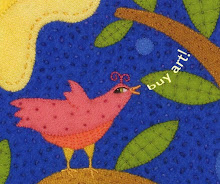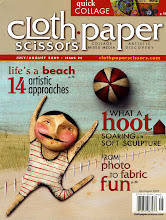I get asked a lot of questions about my work,
but one of the most common is:
"Susan, how do you frame/mat/mount your pieces?"
So I decided we'd take those issues one at a time, and took some photos during my last framing adventure so that I could show you why I complain so much during framing week
(as well as give you an idea how you could do it yourself, if you were looking for a fiber art framing solution).
Don't worry -- I'll try to make this tutorial fast and fun . . . and NO TEST!
Today we will look at the actual frames:
My frames begin life as a simple, blank wood frame with a plain profile, and are made from either 2" or 3" stock, depending on which I think will work best for the specific piece. One of the things I take into account is the necessary depth of the frame, because the 3" frames end up deeper than the 2". (I also consider whether or not I will want dots. If there are going to be dots, the 3" is always the choice.)
I make my frames quite over-sized, to allow a lot of room for the piece to "breathe" visually -- I want to enhance the piece and give it some graphic punch on the wall, not compete with it. My main intent is to get the viewers' attention, and then I hope that the minutiae of the piece will draw them in and hold them long enough to appreciate its subtler aspects.
My pieces require quite a bit of depth to frame -- at least 1". My frames begin with 1/2" rabbet, and then I add depth to the back. This also allows the piece to "float" on the wall, a look I like.
4 pieces of wood are cut to fit the back opening exactly, then nailed and glued in place. I use quite a slim piece for the 2" frames, heavier for the 3". Corner braces are added to increase stability -- my pieces can be quite heavy.
After the back is built, the frame is sanded. The front joints are filled with an epoxy wood-filler, perfect for getting high inadvertently or clearing the kitchen of pesky family members (actually, a plea for help sanding has usually already cleared them from the house at this point.)
Any additional imperfections/nail holes are filled with regular wood filler. The frame is thoroughly sanded when dry.
Two coats of black gesso are applied to the frame, front and back. I find gesso to be the great equalizer -- it is the magic elixir of the paint world and turns whatever it touches into a perfectly paint-worthy surface.
When thoroughly dry, the frame is sanded again. Then two coats of black paint are applied to the back of the frame.
Now the fun begins
(and sometimes the swearing). I figure out what color the frame should be, taking into account all kinds of things besides the colors in the piece. Where would someone be likely to hang it? Will it play nicely with the other work in my booth? Would I have a giant bubble-gum pink frame in my house? These are the kinds of questions that are weighed at this stage.
I thin the paint a bit and use a large brush to cover the frame with a wash of color. I want a little of the black to show through, but two coats are usually required to achieve a finish that is even enough.
Note: If I want additional colors to peek through, base coats of each color I want are applied. An ordinary household candle is rubbed over the surface where I want the color to show. After the frame is painted, it is sanded and the paint lifts off everywhere there is wax, exposing the additional colors.
Next I decide what decorative element will be applied. If it's dots or checks, it's freehand. These are usually tone-on-tone with the color of the frame. Again, I am hoping to enhance but not compete.
Sometimes I use a stencil or stamp to apply a design randomly to the surface. During this particular framing session, both frames fell into the stencil category. I inherited a lot of interesting stencils from my years of working for magazines (and guard them jealously. Woe unto the child who borrows them and lets paint dry all over them . . .
HANNAH.)
After the design has dried, the edges of the frame are painted black. I do this by running a small foam brush along the sides, making a sharp edge . . . which doesn't show well here because the frame is charcoal. But you can see how much it floats above the surface of the counter.
Finally, the frame is sanded with fine grade sandpaper, revealing a bit of the black underneath and helping the pattern seem a bit more organic and less like it is just laying on top.
Now the finishing! This stage is fraught with peril . . . tears have been shed, my friends, when the polyurethane gods have been unkind. It seems that there are many things that can affect the quality of your final finish, and I have neither identified nor mastered that list of variables. So I'd recommend you take a DEEP BREATH (because you're going to be holding it for two days) and then get a NEW foam brush and a can of Minwax Fast-Drying Polyurethane. STIR WELL WELL WELL.
Pour a little into a dish and begin brushing it on. There may be tiny bubbles, but these will resolve themselves as the finish settles.
Follow the directions on the can as to dry time -- this next step is a killer
(gulp!) but necessary -- and when the first coat is dry, SAND THE ENTIRE FRAME with fine (400) grade sandpaper. It will look AWFUL.
You will wail, "WHAT HAVE I DONE??!!" You will vow never to sand in between coats again (but you will.) Carefully remove all sanding dust (I use a lightly damp cloth) and apply a second coat in the same manner. When the frame is thoroughly dry, go over it with a little 0000 steel wool and a buffing cloth to remove any streaks that may have appeared (these are pesky on black especially).
This is a tool I absolutely cannot live without. I would save it from my burning house.
After the piece is in the frame, use a brad driver to insert brads.
Hardware and hanging wire and a signed and dated label . . . and
VOILA!
See? You, too, can do it . . . but would you want to? Some days it's a valid question. But the best things in life often require a few steps and a bit of patience.
(And those things usually end up being worth it.)
We'll tackle mounting/matting at a future date.
Now . . . Any questions?
What?
When am I coming back from vacation?
Oops! Did I forget to mention vacation? Yes, the entire staff at
Small Works (that's me) is flying to my beloved red rock desert for a week of ill-timed (because I'm going to miss the only week of my blossoming trees in MN) sunshine and overeating.
If you miss me, you can look at any of my previous posts about fear of flying, how much I love the desert, our inability to escape our genes, how beautiful my crab apple trees are for a split second per year, or guacamole. That should cover just about everything.
Small Works will return May 19, but there will be smart people here every day with an inspirational quote just for you.
XO one and all!
Miss you already!













































































